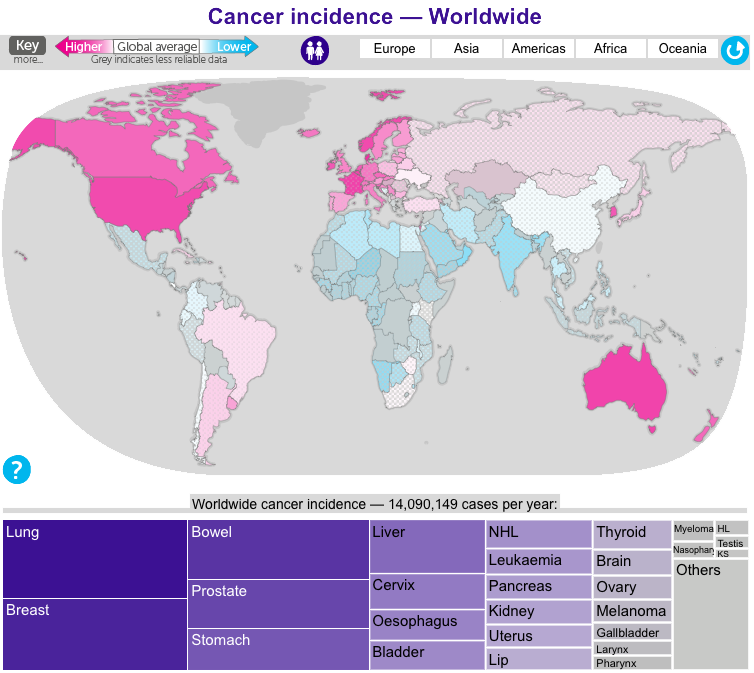Introduction: Cancer and Its Leading Causes
In 2014, cancer topped the lists of the leading causes of death in the world. Despite numerous treatment strategies, the instances of cancer development remain just as numerous. Because of the shift towards a more sedentary lifestyle and development of bad habits, as well as the radioactive effects of modern technology (e.g., cell phones), people are more prone to developing cancer nowadays than they used to be several years ago.
When it comes to the analysis of the factors triggering the development of cancer, one must admit that a range of these factors still remain unidentified. In other words, the basic sources of threat, such as exposure to radiation, have been identified. However, in a range of cases, patients are diagnosed with CUP, or Cancer of Unknown Primary (Pavlidis and Fizazi 244). Therefore, at present, a limited amount of factors triggering the development of cancer tissue can be identified. Among the key ones, the following factors must be listed:
- Exposure to radiation (cell phones, computer tomography, interventional fluoroscopy, etc.);
- Exposure to sun radiation;
- Tobacco consumption;
- Genetics (tested with BRCA and BRCA2);
- Infectious agents (particularly, HPV);
- Increase/reduction in hormones production (especially Diethylstilbestrol (DES));
- Exposure to chemicals and specific environment (hair dyes, aerosols, etc.);
- Harmful food consumption (alcohol, fast food, fluoridated water, etc.) (National Cancer Institute para. 1–10)
Cancer in the 21st Century: When the Threat Starts to Grow
Even years of development of cancer treatment and prevention options, the disease remains the top cause of death all over the world (International Agency for Research on Cancer para. 1). According to the 2014 report, the number of cancer patients is increasing steadily, despite the prevention measures used. As for the latest record, the 2014 World Cancer Report statistics shows that in 2012, there has been a major increase in the number of cancer patients. 14,100,000 new cancer cases have been registered, and 8,200,000 of them resulted in death of the patient; moreover, in 2012, 32,600,000 people were living with a cancer diagnosis (International Agency for Research on Cancer para. 4). The latest calculations show that in two years, the number of cancer patients will estimate 22,000,000 people (International Agency for Research on Cancer para. 4).
The increase in the number of cancer patients is quite understandable, though obviously sad. In the realm of the information society, physical activity has nearly become obsolete. A range of programs have been designed in order to promote the idea of a healthier lifestyle, yet most people prefer to resort to the traditional sedentary lifestyle (National Center for Chronic Disease Prevention and Health Promotion 18). In addition, the number of smokers has grown significantly compared to the amount of non-smokers. It is supposed that the aforementioned facts have foreshadowed a sharp increase in the number of cancer cases.
Among the most problematic issues regarding cancer and its treatment, the fact that the disease may affect any part of the patient’s body needs to be outlined. There are a variety of types of cancer; lung and breast cancer are clearly the most widespread types at present, yet the threat of melanoma, myeloma, etc. is not to be ignored, either, the table below shows:

Cancer Treatment in the Age of Information Technology
Much to the credit of the current system of healthcare and the efforts of nurses all over the world, the process of cancer treatment has become considerably more successful. With a fast and efficient diagnosis and the appropriate treatment procedures prescribed, the threat of complications or lethal outcome may be reduced to zero. At present, there are several ways of addressing cancer depending on its type, stage of the disease development and other essential factors.
Surgery
Though applicable only on the earliest stages of cancer, surgery still remains one of the most common methods of addressing the issue in question. While surgery is primarily viewed as the method of treating cancer, it can also be performed in order to diagnose or prevent the disease.
Chemotherapy
The specified method offers the greatest control over the treatment process. By injecting a patient with the drugs that prevent cancer from spreading and terminate the disease, healthcare experts are capable of curing cancer.
Radiation
One of the most common methods of fighting cancer, radiation presupposes the destruction of cancer cells with the help of high energy particles.
Conclusion: The Methods of Preventing and Fighting Cancer
Radiation
As it has been stressed above, radiation is also used widely in order to eliminate the slightest chances of developing cancer.
Healthy lifestyle
One of the most common preventive measures against the threat cancer development, a healthy lifestyle presupposes that one should be on a healthy diet and take physical exercises on a regular basis. Moreover, bad habits, including smoking and drinking, must be abandoned for good.
Regular health checks
Though a lot of people see regular visits to a doctor unnecessary, the latter may help detect cancer at its earliest stages of development and, therefore, get rid of the problem comparatively easily.
Raising awareness
The last, but definitely not the least, this approach presupposes that correct information on proper course of actions in case it is suspected that one has started developing cancer. In other words, people must be made aware of the key symptoms of cancer, as well as provided with the means of contacting the nearby healthcare or nursing facility.
Works Cited
Cancer Research. “Worldwide Cancer Incidence Statistics.” Cancer Research UK. 2014. Web.
International Agency for Research on Cancer. “Global Battle against Cancer Won’t Be Won with Treatment Alone: Effective Prevention Measures Urgently Needed to Prevent Cancer Crisis.” World Health Organization. 2014. Web. 1
National Cancer Institute. “Cancer Causes and Risk Factors.” National Institute of Health. n. d.
National Center for Chronic Disease Prevention and Health Promotion. “2014 State Indicator Report on Physical activity.” 2014.
Pavlidis, Nicolas and Karim Fizazi. “Cancer of Unknown Primary (CUP).” Critical Reviews in Oncology/Hematology 54.3 (2005), 243–250.